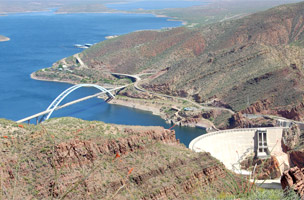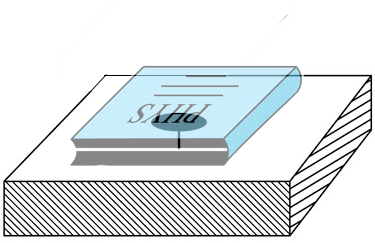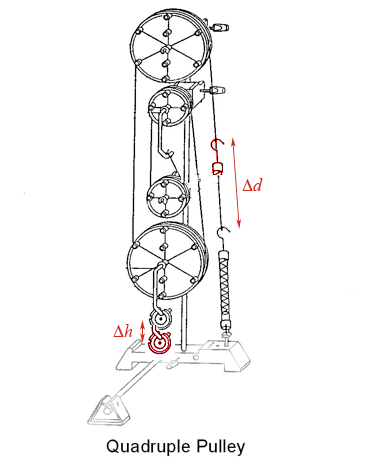Gravitational energy?
- Operative definition: An object has energy if it has the potential to physically change itself or its environment.
- We decided that kinetic energy (KineticE) of a moving object should increase
- if its weight, $w$, increases,
- if its speed, $s$, increases
- We'll use similar reasoning to try and arrive at a rough expression for Gravitational Energy (Grav E).
Gravitational energy

Does a book on a high shelf have the "potential to physically change itself or its environment"?If so, what variables does that depend on?
$$\text{GravE}=...?$$
Here is a picture of a very large "battery" for storing GravE:

Energy of a lifted book
$$\text{Work}=F\cdot d$$
- Weight can have units of pounds [lbs] in the English system and Newtons [N] in the metric system.
- Distance can have units of feet, or meters [m]. N$\cdot$m = Joules, of energy.
In the metric system, the unit of energy is a N$\cdot$m, which is used so often that we give it a special name:
1 N$\cdot$m = 1 "Joule" = 1 J.
Search: How many kilocalories in a Joule?
There are many units of energy: Joules, foot$\cdot$lbs, Megajoules, microjoules, calories, Calories (=kcal), Watt$\cdot$hrs, ...
How much energy does it take to lift a 3 kg book from the floor onto a shelf which is 2 m above the floor?
Weight and force
Weight is one example of a "force"
A force is something that can extend (or compress) a spring.
Of course, your arms can exert a force horizontally, instead of vertically. Does it take energy to push an object across a table?
The energy that your arms do is called:
Work = $F\cdot d$ is an energy transfer from one body to another body.
Recovering the gravitational energy from a lifted object...
- Allowing the book to do work on your hand as you slowly lower the book.
 Resting the book on a tack, which the weight of the book is able to push into a cork board below.
Resting the book on a tack, which the weight of the book is able to push into a cork board below.
Certainly the weight--the force of gravity, $F_g$--is different for heavy and light objects. It seems to be reasonable to expect that heavy and light objects might fall differently. We'll explore that in the next lab.
 Here is a more complicated apparatus for lifting things. See if you can solve this problem thinking only in terms of energy and work, without worrying about the mechanics of how much the bottom pulley moves when you pull the string...
Here is a more complicated apparatus for lifting things. See if you can solve this problem thinking only in terms of energy and work, without worrying about the mechanics of how much the bottom pulley moves when you pull the string...
- How much work, in Joules, does it take to lift a 10 N object by 50 cm?
- Using the pulley arrangement shown, the force on the end of the rope is 1/4 of the weight of the object.
- It should still take the same amount of work to lift the object by 50 cm. How far must your hand (holding the end of the rope) move in order to give the 10 N object the same amount of GravE as in 1.)?